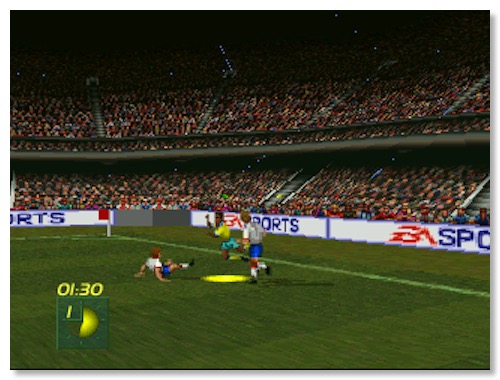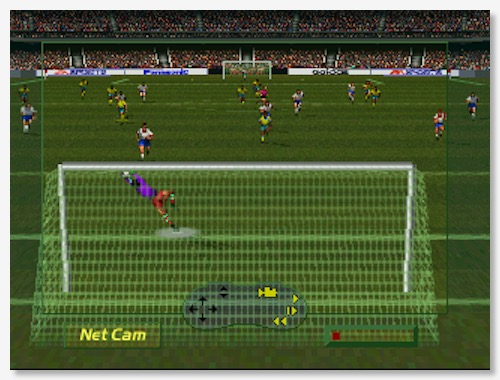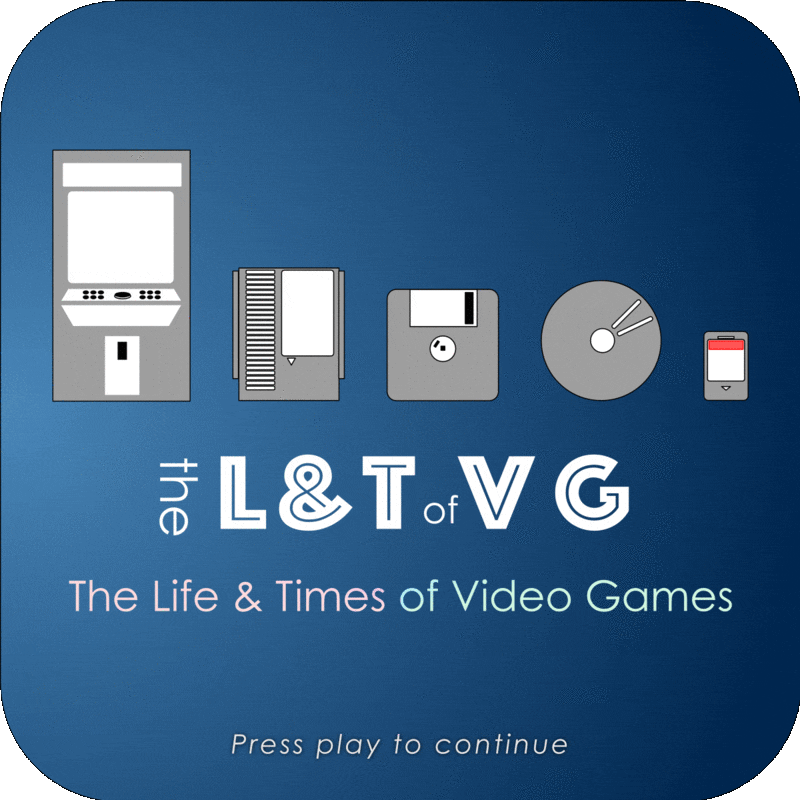5 - FIFA 3DO
Become a Patron!
A story from the dawn of 3D sports games, and the forgotten link between the 16-bit isometric and 32-bit 3D EA Sports games — this is how FIFA 3DO transformed the way sport was represented in video games.

Music Credits:
- Lee Rosevere - And So Then, Theme from Penguins on Parade, and Old Regrets from the album Music for Podcasts 3, and Small Steps and More On That Later from the album Music for Podcasts 4
- Ondrosik - Love is Over, Interlude, Crazy, and Etude from the album Nostalgic and Procrastination
- Revolution Void - Time Flux, How Exciting, and The Narrative Changes from the album The Politics of Desire
- Paleste2 from the Free 20s Jazz Collection on Archive.org
- And a few bits of my own stuff
(Partial) Transcript
Few entertainment franchises today, games or otherwise, can match the mindshare and profitability of EA Sports' FIFA Soccer. Last year's instalment, FIFA 17, for instance, was the best-selling console game of 2016 despite it only being available for the final few months of the year. And that was no anomaly. FIFA sells tens of millions of copies worldwide, year after year, and these days even makes a yearly cameo on the best-sellers list in the United States, a country that thinks football is a sport played by huge men in body armour and helmets wrestling and running into each other while occasionally trying to catch an egg-shaped ball that some other dude throws across a field. Or at least that's how non-Americans like me think of American football.
There was a time when video game approximations of association football, or soccer, as it's also known, were popular on the global stage alone, and when such games were fun diversions — not training aides or sophisticated simulations or large-scale competitive sports in their own right (all of which both FIFA and its arch nemesis Pro Evo are today). A time when soccer simulations effectively went to America to die, when the only sports games with a fighting chance of success in the American market were tennis, golf, and licensed tie-ins to the country's biggest sporting leagues, the NFL, NBA, NHL, and MLB. And that time wasn't so long ago.
To get where we are now with the FIFA video game franchise took four key moments more than 20 years ago. I'm going to focus here on the last of those, but first I need to tell you about the other three.
Trip Hawkins was marketing director in Apple Computer's Lisa division in 1982 when he saw an opportunity to create a video game publishing company that championed its developers as rockstars, as superstar practitioners of an interactive art form. He soon left Apple and founded Electronic Arts, or EA for short, with some of his friends from the computer industry.
They had a few groundbreaking early hits in Bill Budge's Pinball Construction Set, Dan Bunten's M.U.L.E., Eric Hammond's basketball game Dr J and Larry Bird Go One on One, and Interplay's dungeon-crawling role-playing game The Bard's Tale. But Trip Hawkins had a bigger dream than just a successful games company. He wanted to change how sports games were played, to combine the thinking and decision making and strategy and tactics of the real thing with the excitement of watching sport on TV.
One on One was the first game to license the likenesses of professional athletes, and its glowing reception gave Trip the confidence to push on with his dream. A two-player street-style basketball game starring two of the biggest names in the sport was a great start, but they needed to go further.
EA soon expanded its sports game roster, with golf and baseball simulations, and in 1988, after four years of failed attempts to complete the project, they released John Madden Football for the Apple II, the first gridiron simulation that you could directly control with full 11-player teams on the field.
That then led to their journey onto game consoles, and the formation of the EA Sports brand, with a Sega Genesis version of Madden and then an ice hockey simulation called NHL Hockey.
These quickly climbed the best-sellers lists on both the Genesis and the Super Nintendo, and annualised sequels only further solidified the company as kings of the home console sports game space in North America. They had achieved Trip's dream of transforming sports games; they'd refocused the market on TV-style realism, and over the first half of the 1990s they swept up licensing deals for nearly everything — players, teams, stadiums, leagues. They even had organ music and crowd chants and other digitised versions of things you might hear on TV — although full-blown commentary wouldn't be possible until the PlayStation era. If it's in the game, it's in the game, their tagline went, and they meant it.
But for all of their successes and triumphs in the domestic home console space, EA Sports remained largely unknown internationally. Their Madden and NHL games barely registered a blip outside North America, and their basketball and baseball titles weren't exactly grabbing attention. Outside of North America, the only sport videogame that counted was one that involved the round-ball version of football. The international audience favoured soccer management games like Player Manager and the two hot new kids of the block, Premier Manager and Championship Manager, and non-management games like Sensible Soccer and Kick Off.
But EA Sports had never made a soccer game before they began development on FIFA International Soccer, the game that nobody thought would succeed. It had been an uphill battle just to get it greenlit. At one point EA's European office, convinced the company needed to make a round-ball football game, did some market research and put together a case for soccer being the only way for the burgeoning EA Sports brand to make any headway in Europe.
Development duties on the game seemed at first like it might go to a couple of independent developers in the UK, who tried three prototypes — one that scrolled sideways, another that was top-down and scrolled forwards and backwards (which was the viewpoint favoured by the leading soccer games of the era, Sensible Soccer and Kick Off), and a third that was somewhere between the two in an isometric perspective. That angled viewpoint seemed the most compelling, as it mimicked the experience of watching a match on TV.
But before they could take it further, the project got moved to EA Canada. They figured out a way to make the isometric perspective really shine, lending the game an instant wow factor that stood it apart from the competition. EA Canada and Europe worked closely together to get it polished and to start discussions about licensing deals for player and stadium likenesses in future versions. They built up loads of positive hype in the UK. But still the expectation from EA's top brass was of total failure.
Official sales projections ended up at 290,000, but, even with a late holiday season release of December rather than November 1993, they ended up with half a million copies sold for the year. All told, this first FIFA game sold around 600,000 copies. That success had produced a kind of Goldilocks effect for the team that made it. They'd proven the case for an EA Sports soccer title; there would definitely be more FIFA games. But at the same time they were still small enough to have the freedom to experiment. Here's Marc Aubanel, who was assistant producer on that first FIFA and who now took on the day to day management of the team — which for their next project would consist of 12 core developers, including EA's first female lead programmer, Penny Lee.
Marc Aubanel: So we were mildly cool success. And we had one of the team came off the game and we got some 3DO devkits.
Okay, a quick primer on the 3DO. Electronic Arts founder Trip Hawkins left the company in 1991 specifically to make the 3DO, which was a CD-based game console with 3D graphics capabilities that launched in late 1993 — a year before the similarly-equipped Sega Saturn and Sony PlayStation consoles hit Japan and two years before they launched worldwide.
The 3DO was a hugely ambitious idea and an amazing piece of technology, but it also cost a whopping 700 US dollars and as a result wound up selling only two million units over three years. To put that in context, the Sega Genesis sold 31 million or so and the Super Nintendo managed 49 million.

MA: We started to fool around with the devkits and we made a prototype. Probably in I'd say two to three weeks, we had taken FIFA from a wholly 2D game — it was an isometric sprite-based 2D game with locked cameras — and converted it to a two-and-a-half-D game. So we had a single green surface with no field lines or anything on it. No net. No stadium. With 3D cameras and 2D players, billboarded. Basically our Sega Genesis players. They looked like these pixellated — these were 32 by 32 pixel players. So blown up on the 3DO running around.
We had a prototype in two or three weeks and everyone loved it. People went crazy for the prototype. So I'm not sure if the company would have actually said hey guys make a game. I think we just got really lucky we got our hands on a prototype, we came up with a really compelling demo, and people just said hey let's make FIFA for 3DO.
(For more you'll have to either just listen to the episode or sign up as a supporter on Patreon — everyone who pledges $3 or more a month gets access to full episode transcripts [amongst other things].)
The Life & Times of Video Games on the Web and social media
- Website: lifeandtimes.games
- Twitter: @LifeandTimesVG
- Instagram: @lifeandtimesvg
- YouTube: lifeandtimes.games/youtube
You can make a donation to help cover running costs and allow me to rely less on freelance income via
- Patreon: lifeandtimes.games/patreon
- or PayPal: paypal.me/mossrc
Please remember to subscribe and to leave a review on iTunes. A small donation of a few bucks a month on Patreon would go a long way, too, and it'd get you a bit of cool bonus content here and there on a private podcast feed.


